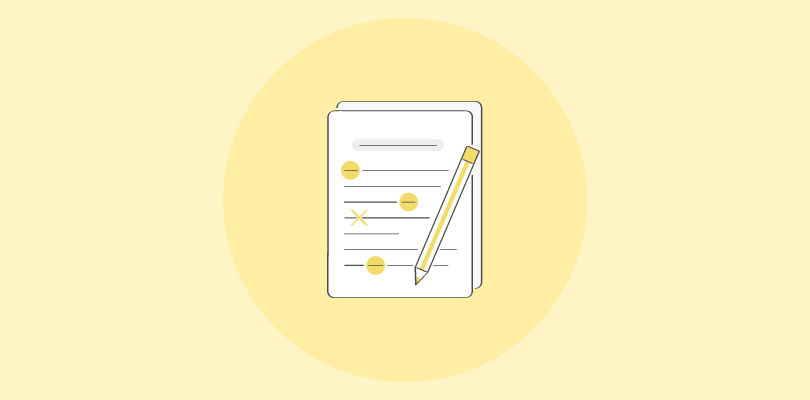If you thought hiring was tough a few years ago, it’s only been getting trickier.
Resumes only tell half the story, and interviews? Well, candidates say what they think you want to hear. I’ve seen this play out firsthand—someone looks great on paper, nails the interview, and then struggles once they’re actually in the role.
That’s why companies are losing thousands on hires that don’t work out.
A behavioral assessment test changes the game. Instead of relying on instincts, you get real insights into how someone thinks, works, and interacts—before they’re on payroll.
Companies that use these assessments don’t just hire smarter—they build teams that last. And in today’s job market, that’s an edge you can’t afford to skip.
This guide breaks down everything you need to know:
✔ What a behavioral assessment test actually is
✔ How companies use it to hire, train, and develop employees
✔ The different types of assessments and which one fits your needs
✔ A step-by-step method to create and run one effectively
Let’s get into it.
What Is a Behavioral Assessment Test?
A behavioral assessment test evaluates how individuals respond to workplace situations based on their personality traits, decision-making styles, and habits. Unlike technical skills tests, these assessments focus on how people think, react, and interact in a work environment.
Businesses use them to predict job performance, cultural fit, and leadership potential. These assessments help in hiring, training, and promotions by identifying strengths like adaptability, teamwork, and problem-solving—or challenges like poor time management or resistance to change.
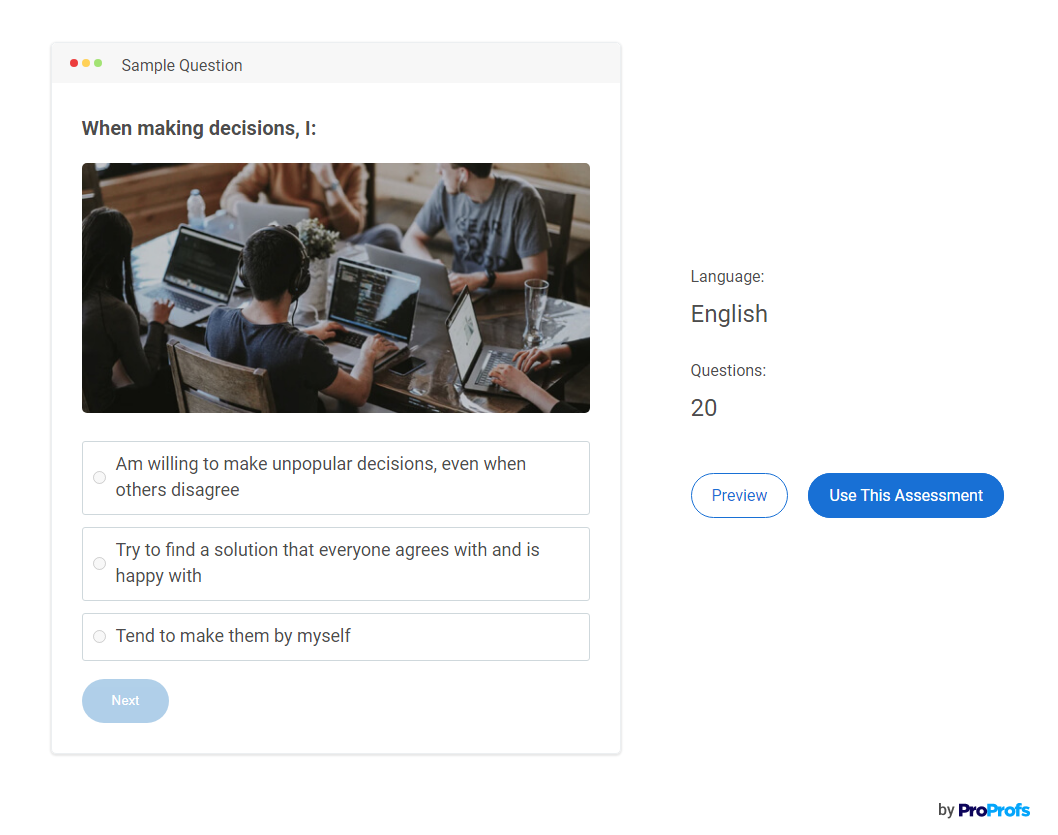
Explore Expert-Designed Behavioral & Psychometric Tests
As Dianne Crampton, founder of team-building and leadership development consultancy TIGERS Success Series, puts it:
“A behavioral assessment measures how people perform and act both emotionally and professionally in common, everyday situations.”
Different types of behavioral assessments exist, from personality tests (like DISC or Big Five) to situational judgment tests and structured interviews. Some rely on self-reflection, while others analyze real-time responses to workplace scenarios.
Functional Behavioral Assessment (FBA)
In more complex workplace situations—like repeated behavior issues, performance that doesn’t improve with coaching, or helping an employee transition back after medical leave—some HR teams use Functional Behavioral Assessment (FBA).
It involves observing the employee at work, asking questions, and tracking what happens before and after certain behaviors to identify patterns and possible causes.
In the workplace, FBA can help you:
- Spot if problems are tied to unclear expectations, overwhelming workloads, or team conflict
- Decide if changes to responsibilities, workflows, or communication can support better behavior
- Create more targeted improvement plans based on real, day-to-day challenges
According to Dianne Crampton, the founder & president of team-building and leadership development consultancy TIGERS Success Series, Inc.,
Why Are Behavioral Assessment Tests Important?
People are the foundation of any business. The right team drives growth, while the wrong fit slows everything down. Three out of four employers admit to making bad hires, and when that happens, it costs them nearly $17,000 on average (CareerBuilder). But hiring mistakes are just one part of the problem.
A great employee today may struggle tomorrow if they don’t adapt to change. Teams break down when personalities clash. Leaders fail when they don’t know how to motivate and manage different work styles. Behavioral assessments give companies a way to see these challenges before they happen—whether it’s during hiring, promotions, or employee development.
By measuring how people respond to pressure, collaborate with others, and solve problems, businesses can make smarter decisions at every stage of the employee lifecycle. Instead of hoping someone will succeed, you’ll have the data to help them do it.
How to Conduct a Behavioral Assessment
Creating a behavioral assessment that works starts long before you send out a test link. This section walks you through how to design and run assessments that reveal real behavioral traits—not just textbook answers.
Whether you’re hiring, promoting, or planning development, the steps below show you how to get it right using expert-backed methods and practical tools.
Step 1: Identify the Behaviors That Matter for the Role
Start by defining the behavioral traits that truly impact performance in the specific job. Instead of relying on general soft skills lists, work closely with team leads, high performers and HR to determine which behaviors contribute to success and which ones lead to underperformance.
Use these methods:
- Behavioral Benchmarking: Review top performers in the same role. What do they consistently do well?
- Job Observation: Shadow someone in the role or speak with their manager to understand the day-to-day behavioral demands.
- Incident Analysis: Reflect on past situations where employees either excelled or failed in the role. What behaviors played a key role?
From this, identify 4–6 essential behaviors you’ll assess. For example:
- In a fast-paced support role: responsiveness, emotional regulation, multitasking
- In leadership: visioning, delegation, composure under stress
- In team-based environments: collaboration, empathy, accountability
Document each behavior with examples so that your team has a shared understanding of what you’re evaluating.
Step 2: Match Behaviors to the Right Question Formats
Once you’ve nailed down the traits, the next step is to select the best way to observe them in action. Don’t default to one question format across the board. Different behaviors show up in different ways.
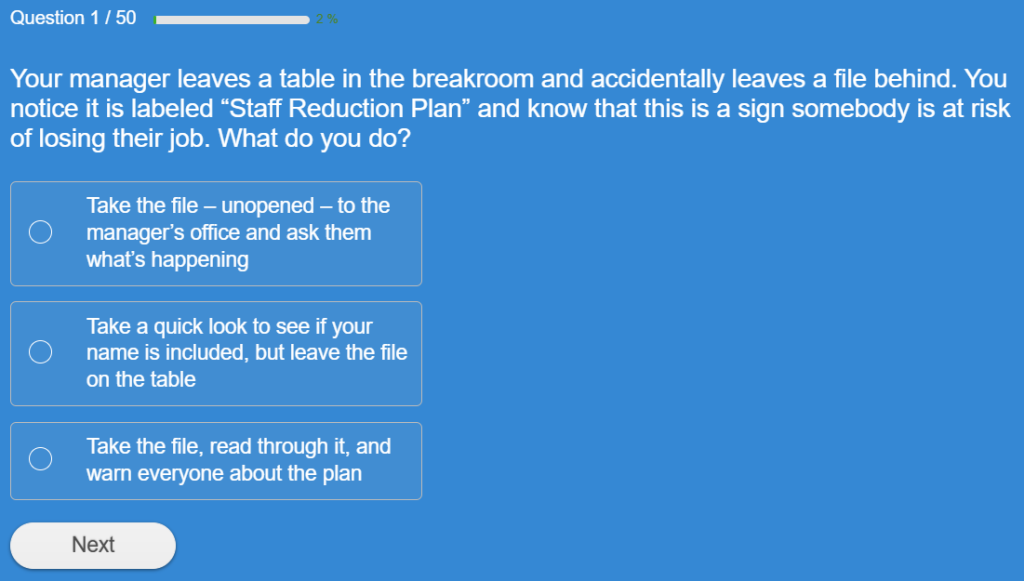
Here’s how to choose smartly:
- Use situational MCQs for traits like decision-making, ethical reasoning, and conflict resolution. These offer controlled variability, meaning you can present several clearly different behavioral responses to the same scenario and observe how the test taker thinks and acts.
- Apply Likert-scale questions (e.g., rating from “strongly disagree” to “strongly agree”) for self-perception behaviors such as stress response or adaptability. While self-reported, they can still offer insight—especially when used alongside other methods.
- Include open-ended prompts or video response options to see how people communicate under pressure, express empathy, or structure a response in their own words.
- Use ranking or prioritization tasks to test time management, focus, and critical thinking—especially in operational or managerial roles.
Don’t try to capture everything with one type. Mixing formats creates a more complete picture. And if you’re using an online tool, make sure it allows for question branching or logic flows (where the next question changes based on the test taker’s response) so the assessment can adapt in real time.
Step 3: Design Questions Around Real Job Scenarios
Effective behavioral assessments simulate real challenges. The aim is to see how someone would react—not just what they claim they believe.
To design your questions:
- Start with a real scenario someone in the role might face
- Keep it specific and detailed enough to mirror actual decision-making
- Avoid generic prompts like “How would you handle stress?”
Example (for project coordination):
You’re leading a project and realize one team member hasn’t completed their tasks, putting the deadline at risk. What do you do next?
Options should represent a range of behaviors: take initiative, escalate, ignore, compromise. The goal isn’t to trick participants—it’s to understand their instincts.
In your online quiz tool, you can bring these scenarios to life using:
- Personality quizzes that provide a detailed personality analysis
- Scenario descriptions with optional media (images, short video clips)
- Section-wise grouping for each core competency
- Ready-to-use quizzes for behavioral evaluations
- AI quiz generation for creating knowledge assessments
Watch: How to Create a Quiz Instantly Using AI
If your platform supports feedback after responses (like ProProfs does), you can use this to explain why certain responses align better with the role. This turns your quiz into a dual-purpose tool: assessment plus learning reinforcement.
📌 Tip:
Keep each scenario tied to a specific behavior. A question about conflict should focus on emotional control, assertiveness, or diplomacy—not decision-making or time management.
Step 4: Pilot and Refine the Assessment Internally
Before using the assessment externally, pilot it with a small internal group. This isn’t just a quality check—it’s a strategic step to eliminate ambiguity, detect bias, and make sure you’re measuring what you intend to.
Run the assessment with employees at different levels:
- Ask for feedback on question clarity and scenario relevance
- Compare results across departments or experience levels
- Look for patterns in responses—do the high performers actually score higher?
During this test run, use your platform’s reporting tools to:
- Review how long participants spend on each question
- Identify any questions that nearly everyone gets “right” or “wrong”
- Export data to find inconsistencies or confusion around specific items
This refinement step makes your assessment more accurate and credible. Even small changes in question wording or answer framing can drastically improve the quality of insights you get later.
Step 5: Share the Assessment Thoughtfully
Once your behavioral assessment is ready, how you share it matters just as much as what’s in it. Whether it’s for hiring or development, thoughtful delivery can improve both response quality and completion rates.
- Explain the why. Let participants know how the results will be used. Transparency encourages honest answers.
- Set expectations. Share how long it takes and whether they’ll receive feedback.
- Offer flexible access. Use email, secure links, or embed it in your portal. Ensure it works across devices.
With ProProfs Quiz Maker, you can:
- Share assessments via secure links or embedded widgets
- Control quiz visibility (public or private)
- Send automated invites and reminders
For hiring, send the assessment between resume screening and interviews. For employees, include it in a training program or performance review cycle.
Step 6: Evaluate Results With Context, Not Just Scores
Insights come from how you interpret the results—not just what they scored.
Here’s what to focus on:
- Behavior-level performance: Review how each trait was demonstrated, not just the overall score.
- Completion patterns: If someone rushes through critical questions, they may not be taking it seriously—or the item might be poorly framed.
- Response trends: Look for red flags like consistently avoiding confrontation or choosing extreme Likert options (e.g., always “strongly agree”).
Using ProProfs Quiz Maker, you can:
- View detailed reports per participant
- Download question-level and summary stats
- Use the grade book for team-wide analysis
- Track completion rates and drop-off points
- Track time spent by someone on the quiz and each question
Watch: How to Review Quiz Reports & Statistics
📌 Tip:
For major decisions like hiring or promotion, combine these results with interviews, peer feedback, or past performance data.
Watch for contradictions too. If someone claims to value teamwork but picks responses that isolate them from group dynamics, that’s worth digging into further.
Step 7: Use Results for Development, Not Just Decisions
Behavioral assessments shouldn’t end with selection or scoring. The real value lies in how you use the insights to develop people and build stronger teams.
For hiring
Use the results to tailor interview questions. Instead of asking general questions, dig into the behaviors flagged by the assessment.
Example:
If the assessment shows low conflict tolerance, ask:
“Tell me about a time you had to confront a coworker—how did you approach it?”
This helps validate the results while giving candidates a chance to reflect on real experiences.
For employee development
Behavioral data can guide personalized coaching and training.
For instance:
- Someone scoring low on prioritization might benefit from a time management course.
- A team member struggling with adaptability may need more exposure to cross-functional roles or fast-paced projects.
For leadership planning
Use the assessment to identify leadership potential—not just based on output, but how people think, respond, and influence others.
Match assessment results with your organization’s leadership competencies and create a development path accordingly.
Want to Improve Your Leadership? Explore Leadership Courses
How ProProfs Quiz Maker helps:
- Create learning modules directly tied to assessment results
- Use custom feedback to explain behavioral implications
- Track improvement over time by comparing pre- and post-training assessment results
📌 Tip:
Don’t just use results in isolation. Layer in manager reviews, peer feedback, and performance data to build a full picture. Behavioral growth is ongoing—it needs support, not just judgment.
⚖️ Important Note on Ethical Use
Behavioral assessments offer powerful insights, but with that comes responsibility. Use them to support growth—not to label, restrict, or discriminate.
- Avoid bias. Craft questions that are inclusive and free from stereotypes.
- Be transparent. Let participants know how their responses will be used and who will see them.
- Don’t over-rely. Combine assessment results with interviews, peer feedback, and real-world performance.
- Respect privacy. Only collect necessary data, and ensure it’s stored and shared securely.
Used ethically, behavioral assessments foster trust, fairness, and better decisions—for your people and your business.
Which Traits Can Behavioral Assessment Tests Measure?
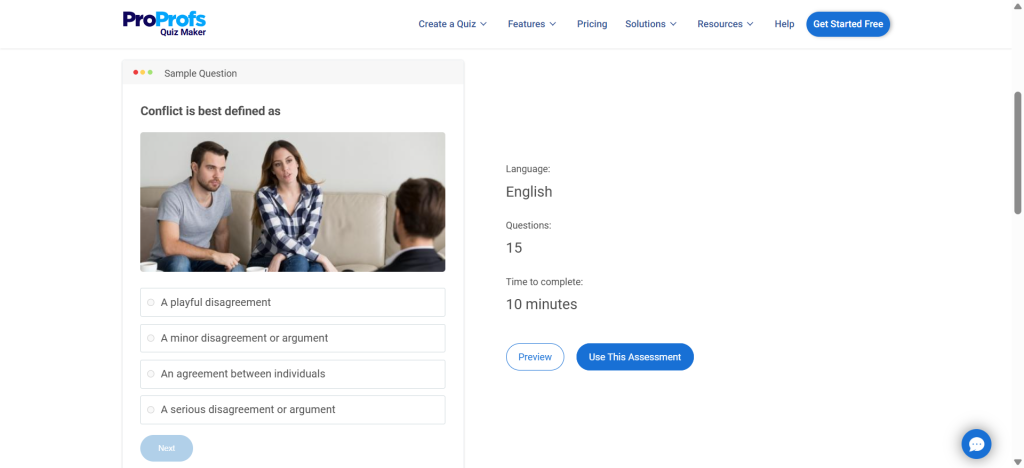
View Conflict Resolution Skills Assessment
Behavioral assessments are powerful tools that can measure a wide array of traits to help organizations understand their employees better. Here are some key traits these assessments can measure:
- Personality Traits: Assessments can reveal core personality traits such as openness, conscientiousness, extraversion, agreeableness, and emotional stability, helping employers understand how individuals might fit into their teams and organizational culture.
- Cognitive Abilities: These assessments can gauge cognitive skills like critical thinking, problem-solving, and decision-making abilities, which are crucial for roles that require analytical thinking and strategic planning.
- Emotional Intelligence: Understanding emotional intelligence traits such as self-awareness, empathy, and social skills is essential for roles that involve teamwork and leadership.
- Adaptability: Assessments can measure how adaptable an employee is to change, which is vital in today’s fast-paced work environments.
- Communication Skills: Effective communication is key in any role, and these assessments can evaluate an individual’s ability to convey ideas clearly and listen actively.
- Leadership Potential: By assessing traits like confidence, initiative, and the ability to inspire others, employers can identify potential leaders within their organization.
- Work Ethic and Motivation: Assessments can help determine an individual’s level of motivation, their approach to work, and their commitment to their job.
- Team Collaboration: Understanding how well an employee works within a team, including their ability to cooperate and support colleagues, is critical for team dynamics.
- Conflict Resolution: Assessing an employee’s approach to handling conflicts can provide insights into their problem-solving skills and their ability to maintain harmony in the workplace.
- Stress Management: Evaluating how employees cope with stress can help in placing them in roles where they can perform optimally without being overwhelmed.
FREE. All Features. FOREVER!
Try our Forever FREE account with all premium features!
Types of Behavioral Assessment Tests in the Workplace
In this section, we’ll explore the common behavioral assessment methods used in the workplace.
1. Personality-Based Assessments
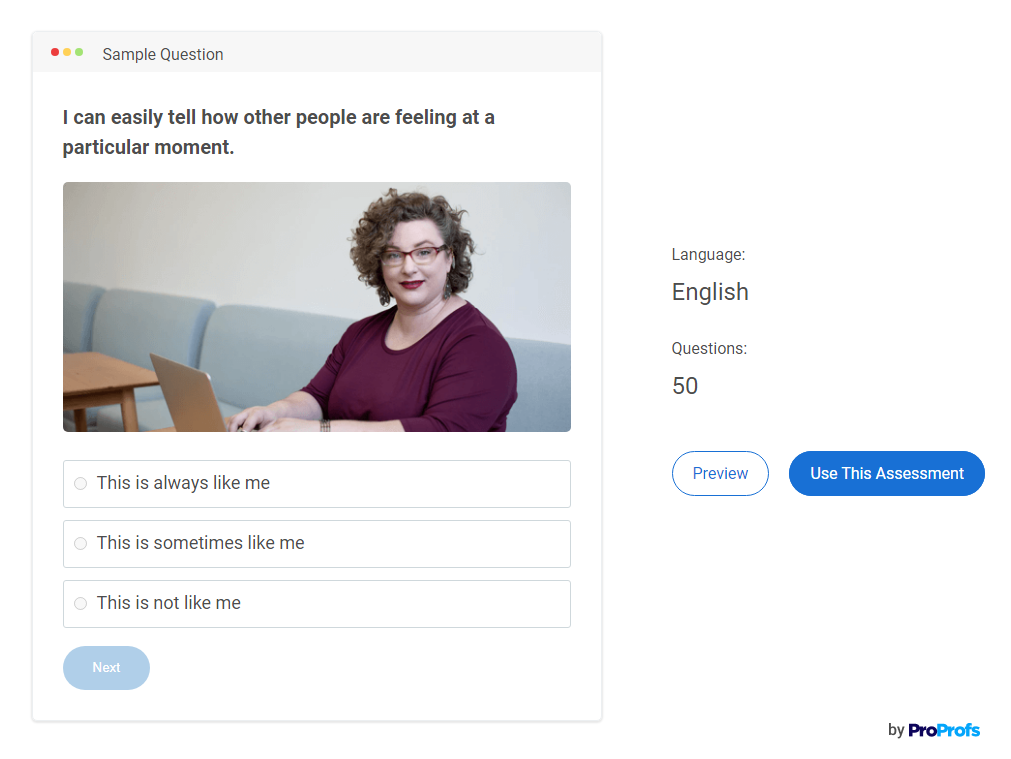
Personality-based assessments, such as the Myers-Briggs Type Indicator (MBTI) or the Big Five Personality Traits, provide valuable insights into an individual’s typical behavior patterns, traits, and preferences. They help identify an employee’s strengths, weaknesses, and preferred work styles.
By understanding employees’ personalities, organizations can effectively tailor job responsibilities and identify potential areas for growth and development.
Watch: How to Create a Personality Quiz
2. Cognitive & Emotional Intelligence Assessments
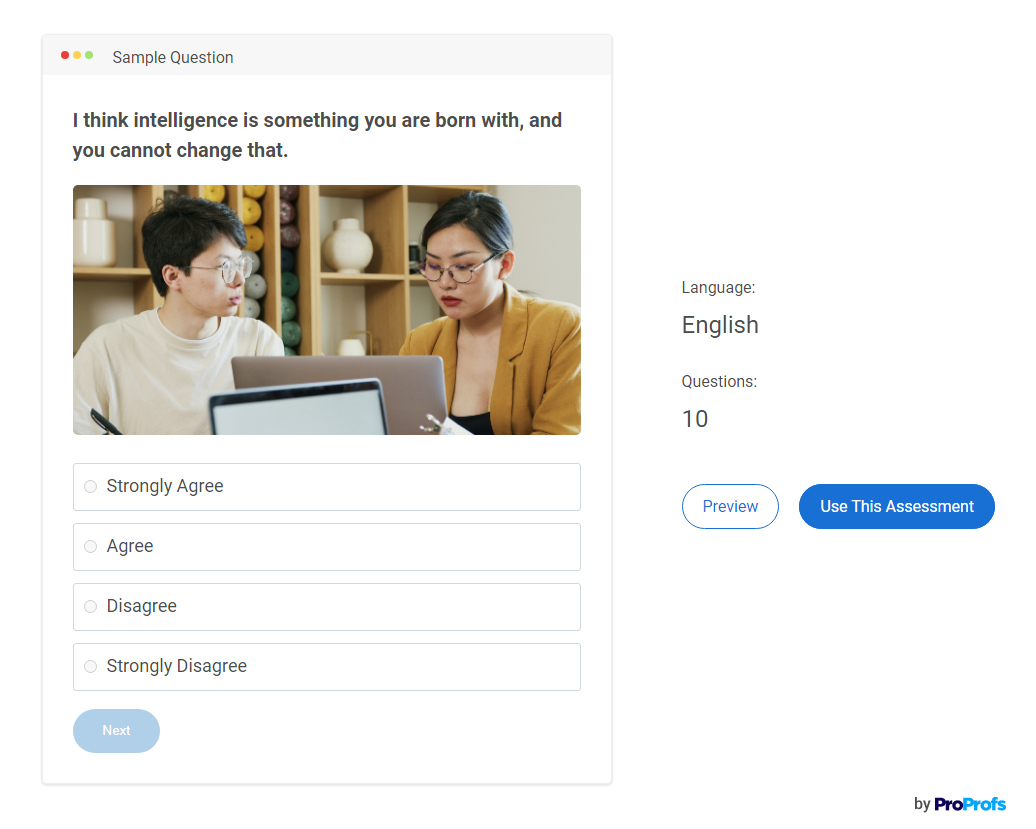
Cognitive assessments evaluate an individual’s mental ability and problem-solving skills, while an emotional intelligence assessment measures competencies such as self-awareness, self-regulation, empathy, and social skills.
These assessments help organizations identify employees with strong cognitive abilities, critical thinking skills, and emotional intelligence, which are valuable for roles that require complex problem-solving, decision-making, and effective interpersonal relationships.
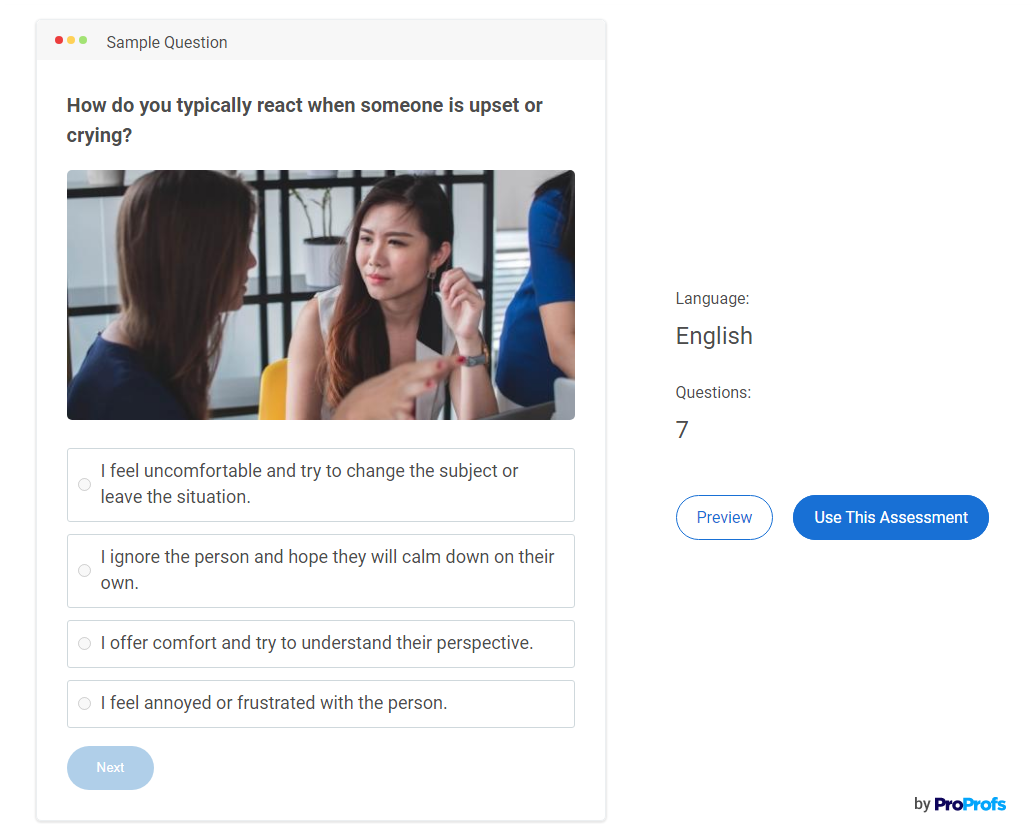
3. Soft Skills Assessments
Soft skill behavioral assessment tests evaluate an individual’s abilities in areas such as time management, task management, self-management, communication skills, and other behavioral competencies.
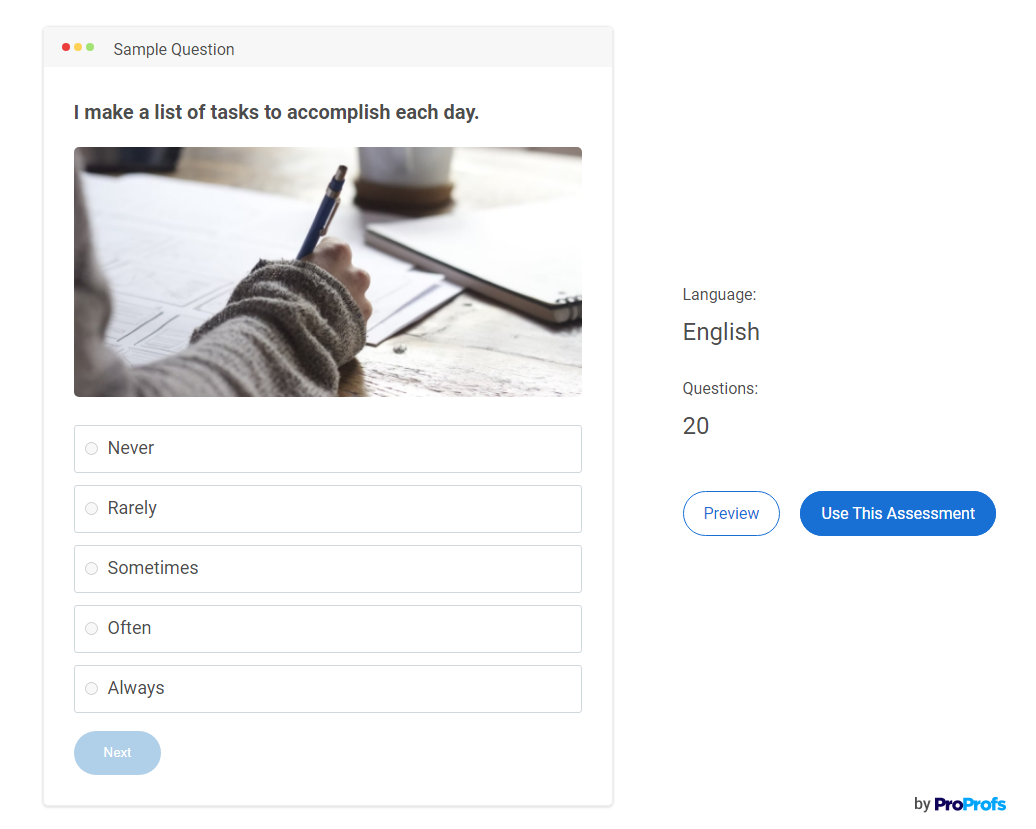
These assessments help in understanding how employees organize their work, manage their time, communicate with others, and regulate their behavior in a work environment. Such assessments can be conducted through interactive scenarios, self-report surveys, and feedback from colleagues and supervisors.
4. Behavioral Interviews & Situational Judgment Tests
Behavioral interviews and situational judgment tests assess an individual’s behavior and reactions in specific work-related situations. These assessments help organizations gauge a candidate’s future behavior based on past behavior and responses to hypothetical scenarios.
Organizations can use these assessments to assess an individual’s decision-making skills, problem-solving abilities, and interpersonal skills.
Pro Tip: You can conduct behavioral interviews in a highly flexible way using video interview quizzes. Such quizzes let the interviewer and interviewees record their questions/responses anytime, anywhere, making the interview process highly convenient.
Watch: How to Create a Video Interview Quiz
5. 360-Degree Feedback Assessments
360-degree feedback assessments involve gathering feedback about an individual’s behavior and performance from various stakeholders, including supervisors, peers, direct reports, and customers.
These assessments provide a comprehensive view of an employee’s performance from multiple perspectives and help identify strengths, motivation levels, goal-orientedness, and opportunities for improvement.
By using 360-degree feedback assessments, organizations can gain a holistic understanding of an individual’s behavior, facilitate targeted development plans, and improve leadership.
You can collect 360-degree feedback easily by creating employee surveys using an online survey tool like ProProfs Survey Maker. It lets you pick from 100+ ready-to-use and customizable survey templates or build surveys in seconds using an advanced AI question generator.

Watch: How to Create a Survey Using ProProfs Survey Maker
6. Diversity-Sensitivity Assessments
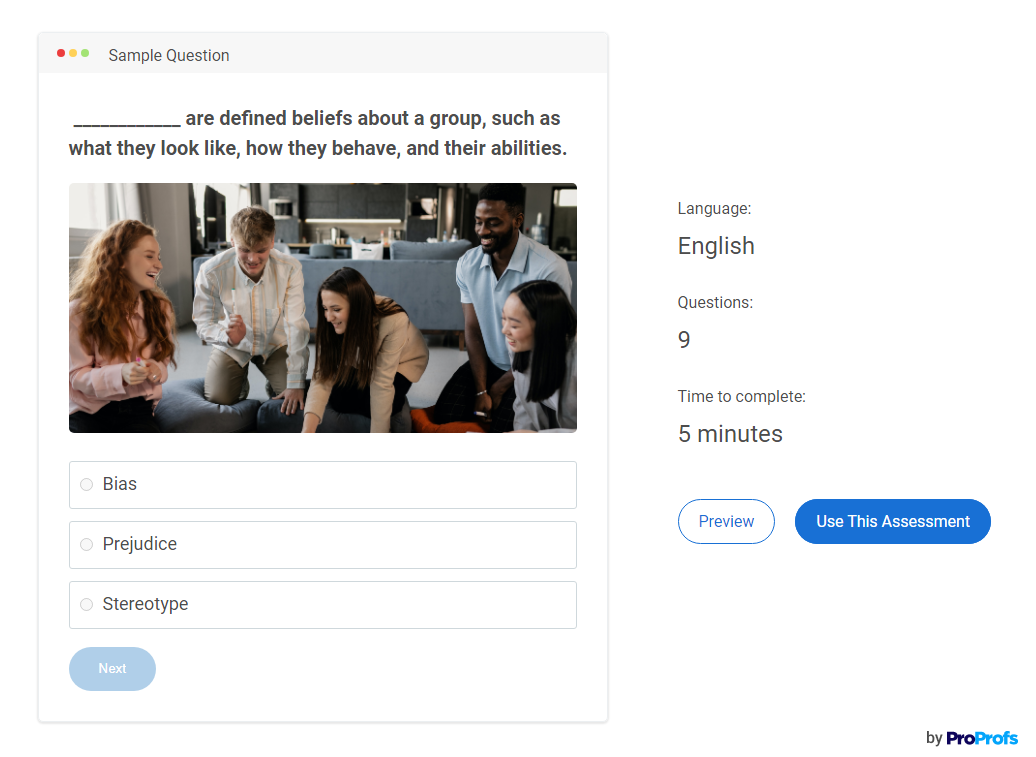
Diversity-sensitivity assessments evaluate an individual’s behaviors and attitudes in relation to cultural differences and diversity.
These assessments help organizations understand how employees approach and interact with individuals from different backgrounds, ethnicities, or cultures. By fostering cultural awareness and inclusivity, organizations can create a more inclusive and harmonious work environment.
7. Observational Assessments
Observational assessments involve watching someone in action—either during real work situations or simulated ones like role-playing or job shadowing.
When you’re conducting this type of assessment, here’s what you should look for:
- Problem-solving approach – How do they handle challenges or unexpected issues?
- Decision-making – Are their choices thoughtful and informed or rushed and reactive?
- Time management – Do they prioritize tasks well and stay on schedule?
- Adaptability – How do they respond to feedback, changes, or pressure?
- Collaboration – Are they team players? Do they support others and resolve conflicts professionally?
By observing these behaviors, you’ll get a clearer picture of how someone actually works—not just how they say they work in interviews or surveys.
8. Self-Report Questionnaires & Surveys
Self-report questionnaires and surveys ask employees to provide information about their own behaviors, preferences, and attitudes. These behavioral assessments can cover a wide range of topics, such as work style, communication style, or conflict resolution.
By collecting self-reported data, organizations can gain insights into how employees perceive themselves, their work environment, and their interactions with others.
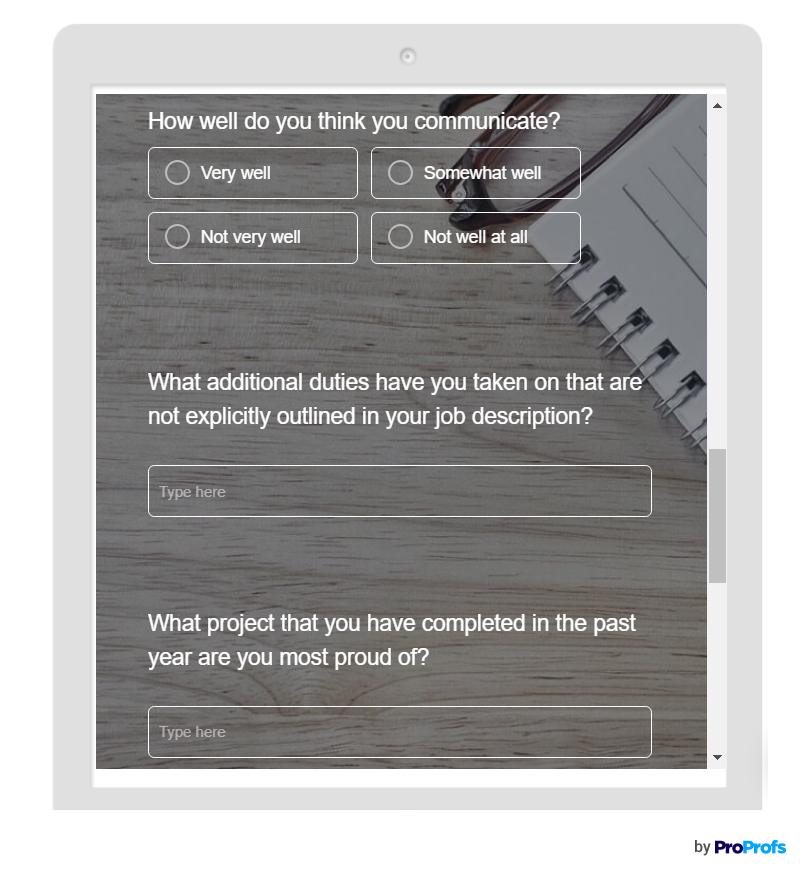
When selecting the appropriate behavioral assessment for hiring or any other purpose, it’s crucial to consider the specific needs and goals of the organization. Each of these assessments uncovers valuable insights into employee behavior and helps organizations make informed decisions that drive success and growth.
Uses & Benefits of Behavioral Assessment Tests
Behavioral assessments have quickly become an essential tool in modern organizational management, offering a range of uses and benefits that contribute to a dynamic and effective workplace.
Let’s explore how these assessments serve as multifaceted tools:
- Enhanced Hiring Decisions
Behavioral assessment tests streamline the recruitment process by predicting job performance and compatibility. By evaluating a candidate’s behavioral traits, companies can make more informed and efficient hiring decisions, leading to a better employee-job fit.
- Personalized Employee Development
Behavioral assessments are instrumental in tailoring employee development programs to individual needs. Understanding an individual’s behavioral profile allows for customized training and development plans, fostering personal growth and skill enhancement.
- More Employee Engagement
Understanding the behavioral drivers of employees enables managers to craft engagement strategies that resonate on a personal level. This approach not only boosts morale but also enhances overall productivity.
- Improved Communication
A deep understanding of individual communication styles, as revealed by these assessments, facilitates better interactions among team members. This improved communication leads to a more collaborative and efficient work environment.
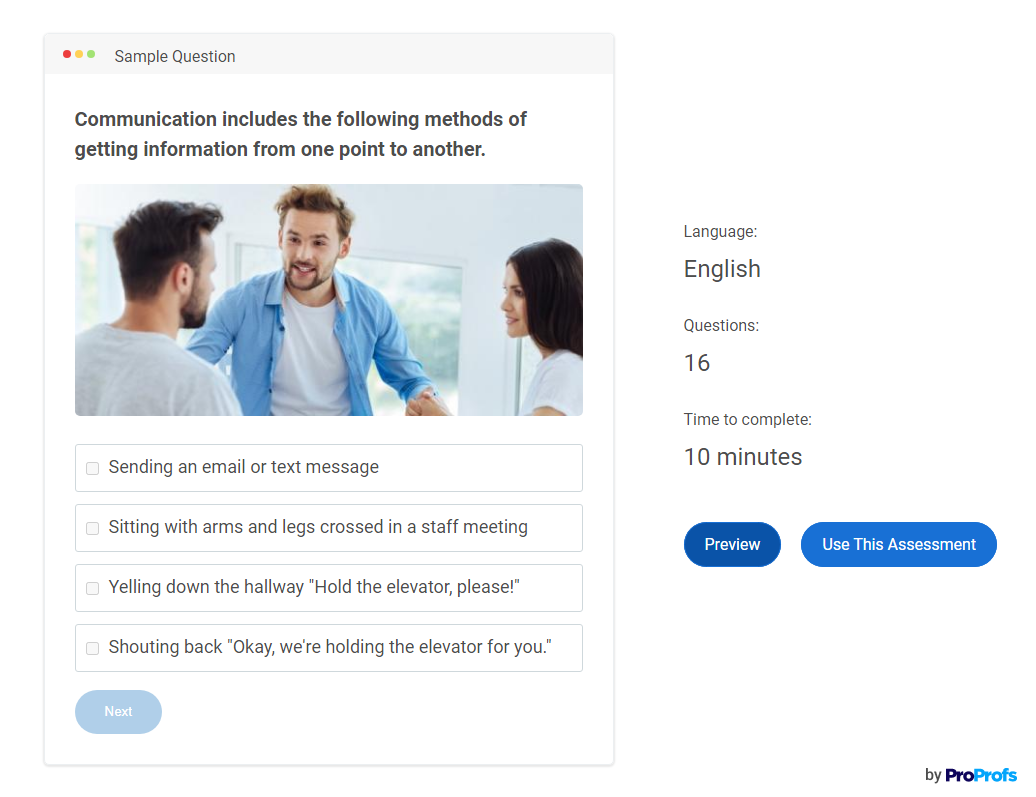
- Effective Conflict Management
By illuminating various conflict management styles within a team, behavioral assessment tests equip managers and employees with the insights needed to navigate and resolve conflicts more effectively, promoting a harmonious work environment.
- Leadership Identification & Succession Planning
Behavioral assessment tools are pivotal in identifying potential leaders by highlighting those with innate traits and skills for leadership roles. This aids in effective succession planning and leadership development.
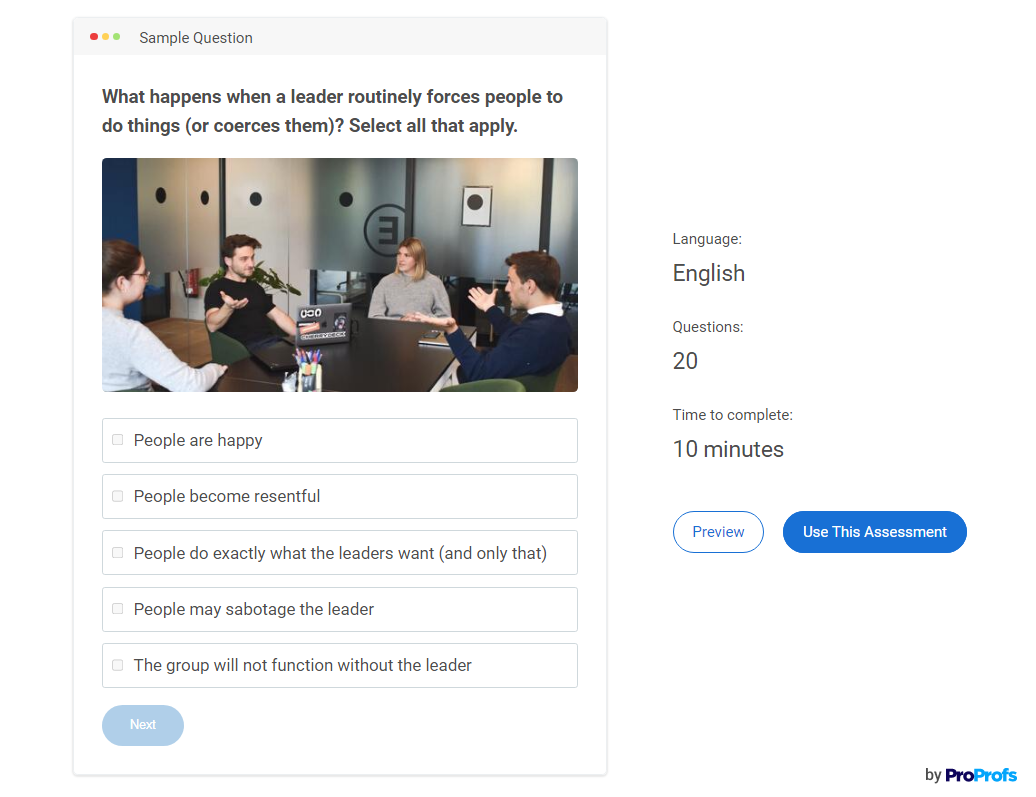
- Team Composition & Transformation
Building teams with complementary behavioral traits leads to a more balanced and effective workforce. Behavioral assessment tests aid in assembling teams that bring diverse perspectives and employee’s strengths to the table, enhancing innovation and team dynamics.
- Comprehensive Performance Reviews
Integrating behavioral assessments into performance appraisals provides a holistic view of an employee’s contributions. It allows managers to understand not just what tasks were accomplished but how they were approached, offering a more nuanced perspective on performance.
In essence, behavioral assessments’ utility extends far beyond mere evaluation; they are integral to shaping a productive, harmonious, and progressive workplace.
From recruitment to leadership development, these tools offer invaluable insights that drive personal growth, enhance team dynamics, and ultimately contribute to the overarching success and sustainability of an organization.
Examples of Behavioral Assessment Tests
If you’re wondering about the available behavioral tests for employment, here are five top ones you can use:
- DISC Test
The DISC test is attributed to William Moulton Marston, an American psychologist. DISC stands for dominance, influence, steadiness, and compliance. The test dissects a person’s personality into these four areas and assesses them.
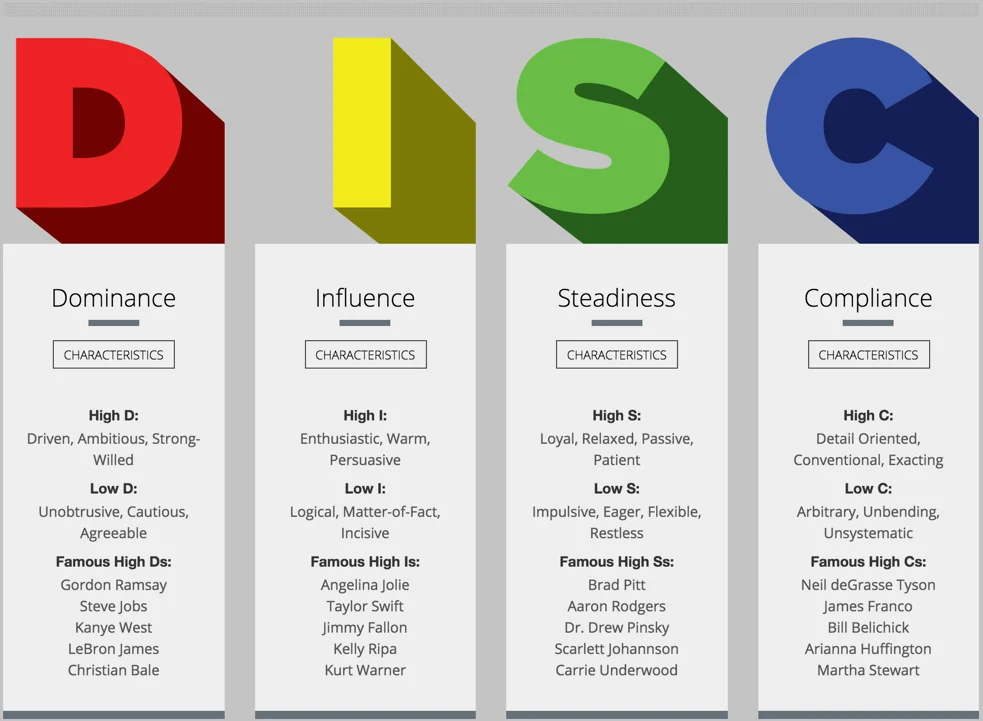
(Source)
How It Works: It works through self-evaluation in the following areas:
- Dominance: How strong-willed or confident employees are about their work
- Influence: How influential or inspiring they are to others and whether or not they’re capable of building meaningful professional relationships
- Steadiness: How stable, consistent, and dependable they are
- Compliance: How task-oriented, cautious, and accurate they are based on their expertise
The DISC test identifies the main personality type of an employee and how they are likely to behave in the workplace. It enables employees to understand themselves better and how they interact with those around them.
Participants self-assess by rating themselves on a scale of 1 (very inaccurate) to 5 (very accurate) on a series of statements about their personality.
Example Question Statements:
- I am always confident about my work
- I like meeting new people
- I am dependable in the workplace
- I prefer doing a task right, not just finishing it
- Big 5 Test
Also known as the Five Factor or OCEAN Test, the Big 5 test is another personality test based on self-evaluation. It’s derived from the five-factor personality model that assesses personality in five areas.
- Openness: How open the assessment takers are to new ideas and activities
- Conscientiousness: How aware they are of their actions and consequences; a sense of responsibility
- Extraversion: How outgoing and sociable they are
- Agreeableness: How friendly, cooperative, and likable they are
- Neuroticism: How emotionally stable they are and what their stress, frustration, and irritability levels are
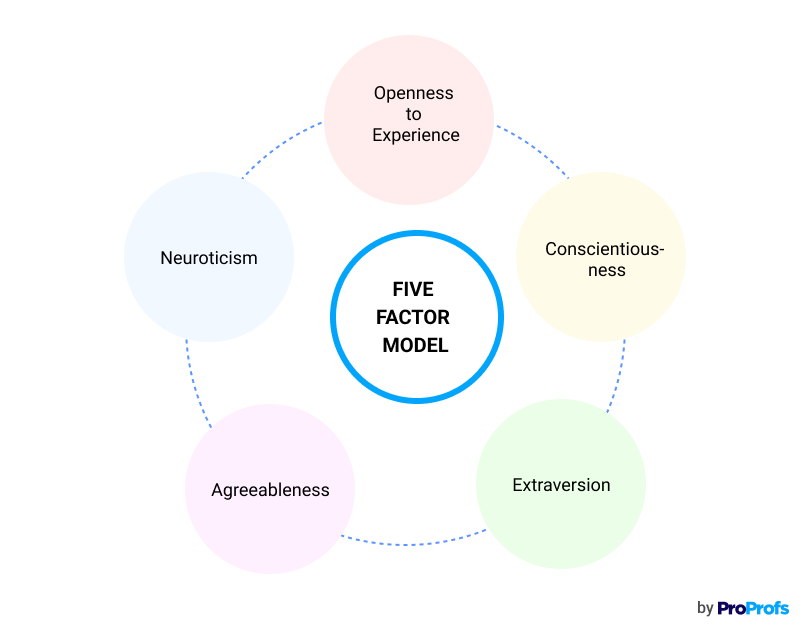
(Source)
How It Works: Participants self-assess by rating themselves on a scale of 1 (very inaccurate) to 5 (very accurate) on a series of statements about their personality.
Example Question Statements:
- I get irritated easily
- My colleagues like to be around me
- I like participating in team activities
- I weigh all the pros and cons before executing a task
- I welcome new ideas and challenges
- Culture Add Test
This test helps you assess whether a candidate’s personal values align with your company’s core principles. But unlike traditional “culture fit” tests that often promote sameness, this one focuses on how someone might add to your culture—bringing in new perspectives while still aligning with your values.
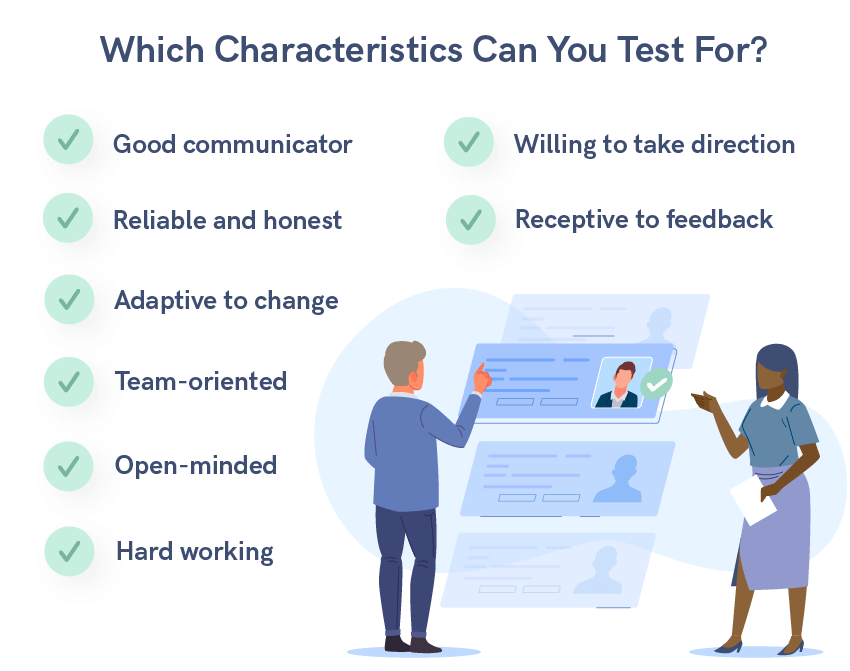
(Source)
How It Works:
You start by identifying the core values that define your company culture—things like transparency, collaboration, ownership, or continuous learning. Then, candidates are asked to reflect on their own values through:
- A survey, where they select values that matter to them and explain why
- Open-ended questions about their ideal work environment, decision-making, and team interactions
- Or scenario-based prompts that reveal how their values show up in action
You compare their responses with your organization’s values to decide if they’ll align—and more importantly, contribute something new and valuable to your culture.
Example Questions:
- What values are most important to you in a workplace, and why?
- Tell us about a time your personal values clashed with a company policy or culture. What did you do?
- What unique perspective or experience do you bring that others might not?
- What kind of culture helps you thrive — and what kind stifles you?
- How do your personal values show up in your day-to-day work?
- Enneagram Test
The Enneagram test maps individuals to nine personality types, each defined by a core motivation and fear. It’s often used to uncover how people interpret the world, manage emotions, and respond in areas like communication, leadership, teamwork, and conflict.
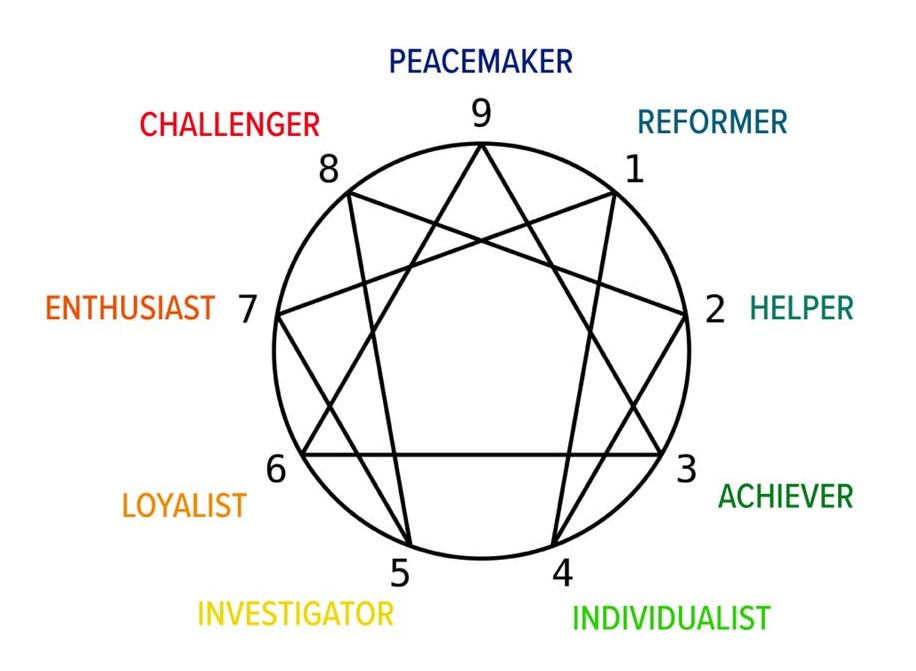
(Source)
How It Works:
This personality system uses a numbered diagram (1 through 9) to represent the nine types. While each person typically leans toward one type, they may relate to aspects of others as well.
The test presents pairs of opposing statements. Participants choose the one that resonates more with them, which helps reveal underlying patterns in behavior, motivation, and emotional response.
Example Question Statements:
- I’d describe myself as a go-getter OR I am a dreamer and always content with life
- I like reconciling conflict situations OR I don’t usually give in but fight till the end
- I like to help people around OR I believe people should seek things out by themselves
- 16 Types Test
The 16 Types test is based on the work of Carl Gustav Jung, a Swiss psychiatrist and psychoanalyst. It’s an introspective and self-evaluation questionnaire to assess participants’ preferences in real-life situations. They can select their choices based on four different dimensions:
- Introversion versus extraversion
- Intuition versus sensing
- Feeling versus thinking
- Judging versus perceiving
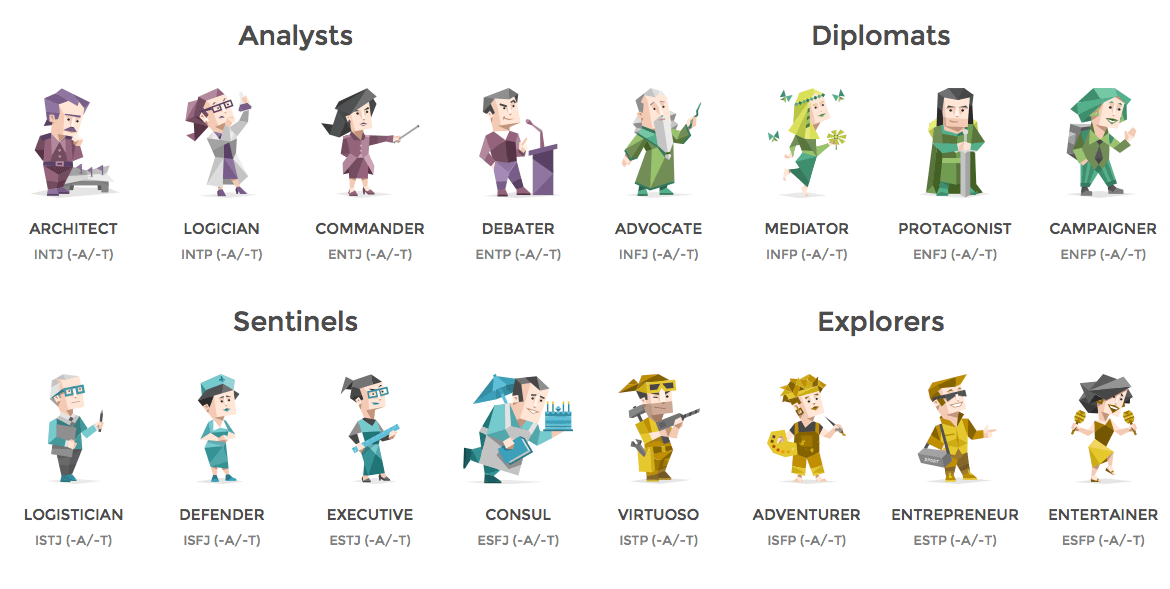
(Source)
How It Works: Test participants must choose between two statements and select the statement that best applies to their personality. The test gives an idea of their likes, dislikes, strengths, weaknesses, and key motivators. This, in turn, helps you see how they may fit into your organization.
Example Questions:
- You focus on: Specifics and facts OR Patterns and relationships
- What do you find most attractive in other people? Intelligence and integrity OR Beauty and charm
- How do you affect people positively? I make them feel relaxed OR I motivate & energize them
- What do you value most? Timeliness OR Spontaneity
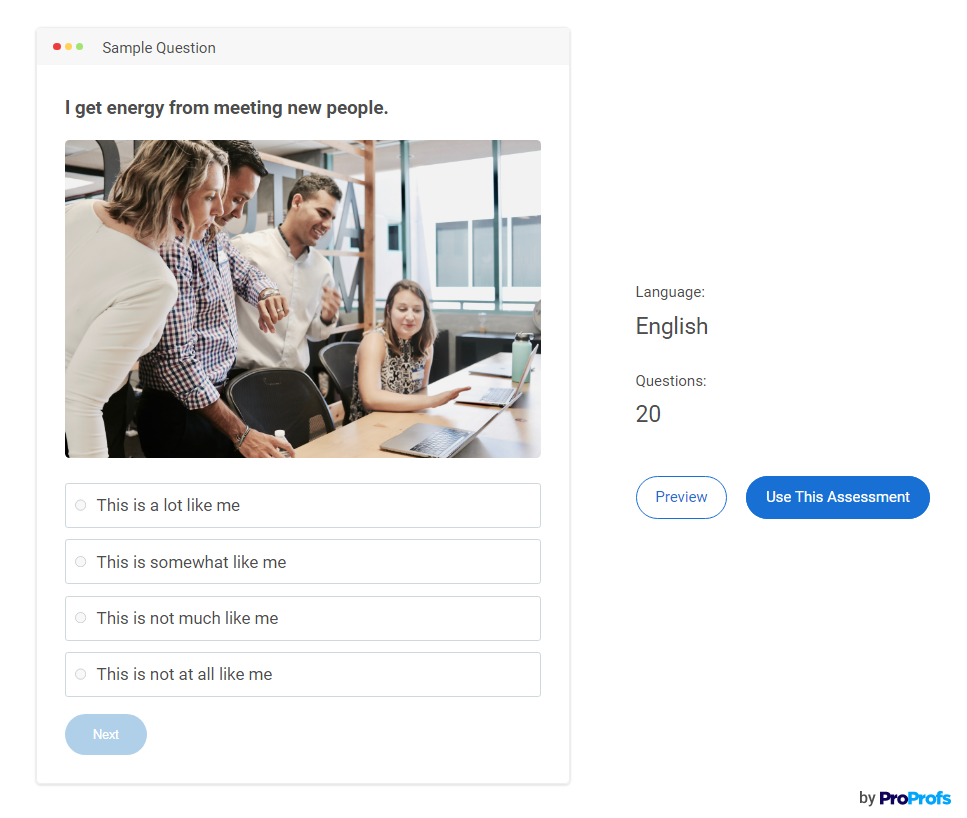
Create & Share Behavioral Assessments With Confidence
A strong workforce starts with smart decisions—and behavioral assessments make those decisions easier. Whether you’re hiring new talent, planning promotions, or identifying development needs, these tests help you go beyond resumes and gut instinct to truly understand how people think, work, and grow.
With ProProfs Quiz Maker, you can create both knowledge and skill assessments as well as in-depth personality assessments tailored to your needs. It also offers pre-designed behavioral and psychometric tests developed by experts so that you can get started quickly and assess the traits that matter most.
From emotional intelligence and decision-making to collaboration and adaptability, ProProfs helps you evaluate real-world behavior—backed by detailed reports that support confident, data-driven decisions.
FREE. All Features. FOREVER!
Try our Forever FREE account with all premium features!
Frequently Asked Questions About Behavioral Assessment
How accurate are behavioral assessments in predicting job success?
Behavioral assessments are a reliable tool for predicting how well someone will perform in a role, especially when combined with other evaluation methods like interviews or skills tests. Since they simulate real workplace situations or explore job-relevant traits, they offer practical insight into how a person is likely to behave on the job. While no assessment is 100% accurate, behavioral tests can significantly reduce the guesswork in hiring, development, and promotion decisions.
Can behavioral assessments be used for all job roles, or are they specific to certain industries?
Behavioral assessments are highly versatile and can be adapted to virtually any role or industry. Whether you’re hiring a customer service agent, promoting a team leader, or evaluating senior executives, the core behaviors—like communication, decision-making, adaptability, or accountability—are relevant across functions. What changes is the context and weighting of those traits, which is why assessments should be tailored to fit the behavioral demands of each role.
How can behavioral assessment tests help in recruitment?
Behavioral assessment tests can significantly improve the recruitment process by:
- Identifying suitable candidates: They help in selecting candidates who possess the desired behavioral traits and competencies for specific roles.
- Reducing hiring mistakes: By providing deeper insights into candidates’ personalities and work styles, these assessments minimize the risk of making costly hiring errors.
- Enhancing interview effectiveness: The results from behavioral assessments can guide interview questions, making the process more focused and insightful.
How often should I conduct behavioral assessment tests?
The frequency of conducting behavioral assessment tests depends on organizational needs, but some general guidelines include:
- During hiring: Conduct assessments for all potential hires to ensure they fit the role and company culture.
- Annually: Integrate behavioral assessments into annual performance reviews to monitor development and identify areas for improvement.
- Before promotions: Use assessments to evaluate candidates for promotions, ensuring they have the necessary traits for new responsibilities.
- For team development: Conduct assessments periodically to understand team dynamics and improve collaboration and communication within the team.
 Tips
Tips
We’d love to hear your tips & suggestions on this article!
FREE. All Features. FOREVER!
Try our Forever FREE account with all premium features!
 We'd love your feedback!
We'd love your feedback! Thanks for your feedback!
Thanks for your feedback!


